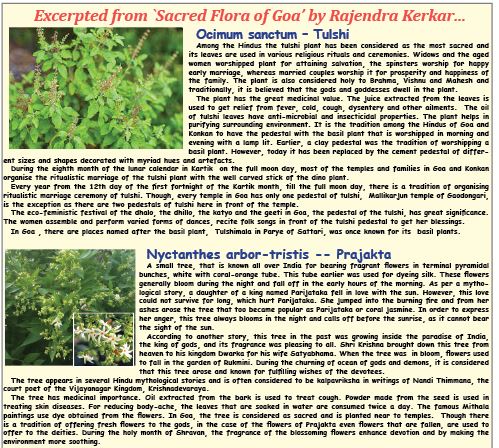Goa is abuzz with excitement as vintage bike and car owners, users, collectors and fans are decking […]

MOTHER EARTH IS SACRED, SAVE HER FLORA!
Dec 10- Dec 16 2022 December 9, 2022AT THE RELEASE OF ENVIROMENTALIST RAJENDRA KERKER’S BOOK “SACRED FLORA OF GOA” ON DECEMBER 5 2022 AT Photo Journalists Art Gallery, Panjim….on the stage are (L to R) are author Rajendra Kerker, guest of honor Dr Pradeep Sarmokadam ( member secretary, Goa State Bio-diversity Board), NABARD Deputy General Manager Vijay Deshpande. The book has been published by Vivekanand Enviroment Awareness Brigade of Keri (Sattari) Goa and NABARD. All who turned up for the occasion were treated to a snack of country poie with mooga ghati, and boiled Goan tuber kaate kanga! It was prepared by Pournima Kerker, the author’s wife.
By Pankajbala R Patel
If you are truly religious in the name of any religion take stock of the quality of Goa’s air, earth, water, food and public spaces….
HAPPY and blessed are those who perceive Mother Earth as the first home of all creatures small and big, and all human beings loving and spiritual enough to respect the gifts of air, earth, water, food and space. Take a look at environment activist and naturalist Rajendra Kerkar’s new book titled `Sacred Flora of Goa’ published by the Vivekanand Environment Awareness Brigade, Rs600. It is a glossy handbook listing the familiar and less familiar sacred flora of Goa which you may have seen every time Chovoth or Ganesh Chaturthi comes along and Goans go forage in whatever wilderness is around them for all the natural bounty which goes into the weaving of the “matoli”– canopy overhead for Lord Ganesh while the deity is being worshipped and invoked in many homes for a few days.
You may have looked at all the intriguing and varied bounty of wild grasses, berries, vegetables, fruit, herbs medicinal or not which makes up Lord Ganesh’s matoli…well, you meet them here in this wonderful handbook full of what is traditionally recognised as the “sacred flora of Goa” (also the Konkan coast homes of the Hindu people).
Mother Earth is sacred for She is our primary mother nourishing us from birth to death and the human of the species who pay no heed to her warnings now manifesting themselves in climate warming (and other so called natural calamities) – may or may not live to see doomsday! Not joking.

An invaluable reminder like “Sacred Flora of Goa” must bring home a vital message for all of us and not least of all the powers-that-be who guide our destiny. Kerkar says we worship the earth first, “Many cultures have the belief that the human beings were born from the Earth and in many languages man is referred as the Earth-born. That is why, the earliest form of worship was probably the worship of the Earth mother, for blessings human beings; fertility, procreation and the world of plants and animals. The prehistoric men were surprised to experience the trees as the food giver, the shelter provider, the medicine supplier and that is why started worshipping their creating abilities….”
Author Rajendra Pandurang Kerkar of Keri-Sattari has done an invaluable service in putting together as many of the “sacred flora” as he could in his handbook, along with the charming traditional stories attached to them in folklore and which one may source only from the people who live simple, hardworking lives in a rural or forested environment. It is not for nothing that we pay serious heed to legends and superstitions attached to some trees and forms of earthly life.
He says, “Since, the ages in Goa there is a tradition of protecting the age old tree, as the abode of the local folk deity. The tree that is protected in the honour of the deity is not to be felled. To cut down a tree associated with the folk deity meant depriving the spirit of the deity of the abode and very often if it became necessary to cut down such tree, special prayer for granting forgiveness used to be performed before a tree is cut down and by observing varied ritual, a spirit of a deity is urged by the devotee to reside on the new tree. Throughout Goa, different species of trees have been protected by the villagers in the name of the folk deities or the unseen holy spirits.”
This is a veritable treasure trove of fascinating things you may or may not know about the flora of the Konkan wilderness and Goa. It is not just the forest and tribal village dwellers who recognise, worship, respect the properties of trees and various flora but also Hindus, Muslims and Christians who have lived on this land for centuries. From the Acacia catechu or khair and Aegle marmelos or bel to the Antiaris toxicaria or chandkudo and hupali tree (mangrove) Rajendra Kerkar offers us all kinds of formal and informal information he garnered through his travels across the Konkan forested lands, talking to village elders and forest dwellers. Plus, he himself is proud to call himself a village boy from Keri taluka in Goa!
This is to say if you want to know more about the kadamb, coconut, peepal, vad, savar, palas, amba, ashoka, arjun, ghoting, avala, jambhul, shami, chinch, supari, satvin, audumbar, ovala, kalam, vavalo, shidam, menkumyo, sagvan, chandan, phanas, dhavorukh, dino, nandruk, shivaling, gorakh chinch, khashta, kosam, kazro, bhedas, harkinjal, nano, kel, hirda, halad, amrut-vel, neem, surangi, jui, prajaktya, kamal, jaee, mogri, tulshi, sonchafa, kevada, roza, patkolni, dev-ciddo, ramachi bota, kunda, bamboo, durva grass, udid, til, dhoop, putranjiva, bhillo mad, kel, aaboli, kindal, apata, bhirand, chandkudo…about tavashache feast and pejyechem feast and konsache feast and kelleam feast and peranche feast and Pentecost feast – it is here in this much-needed friendly handbook of Goa’s trees and plants bearing flower, fruit and seed of the good life that Goans live!
If you are nature’s child you must in fact get all of Rajendra Kerkar’s books for they clue us up about the heart and soul of Goa’s people as reflected in their various seasonal celebrations of Mother Earth’s bounty. Truly, there is no place like Goa and long may it continue to be Goa…never become a stinking, urban, extended extension of a sprawling concrete vertical metropolis like big city Mumbai or Delhi or Chennai or any other urban nightmare. Goa and Goans must really think Mother Earth first.















